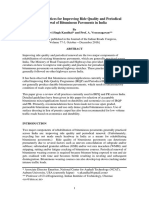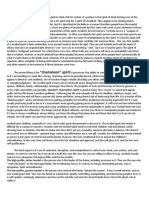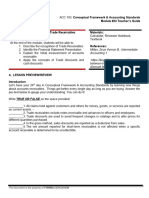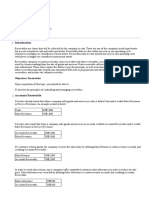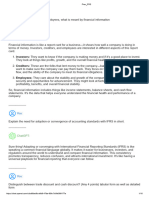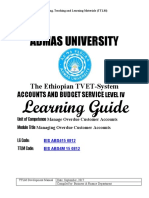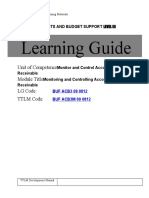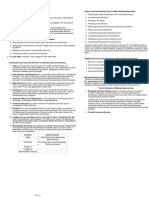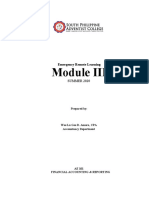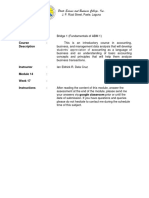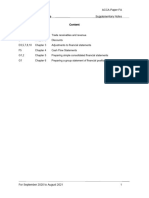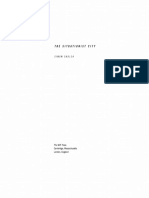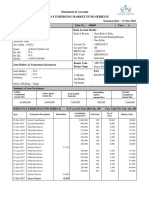Acc-106 TG 6
Acc-106 TG 6
Uploaded by
leisky3.07Copyright:
Available Formats
Acc-106 TG 6
Acc-106 TG 6
Uploaded by
leisky3.07Original Description:
Original Title
Copyright
Available Formats
Share this document
Did you find this document useful?
Is this content inappropriate?
Copyright:
Available Formats
Acc-106 TG 6
Acc-106 TG 6
Uploaded by
leisky3.07Copyright:
Available Formats
Course Code: Course Title
Module #6: INTERMEDIATE ACCOUNTING 1
Lesson title: Accounting for Trade Receivables Materials:
(Accounts Receivable) Calculator, Reviewer Notebook,
Learning Targets: Textbook
At the end of the module, students will be able to:
1. Describe the recognition of Trade Receivables References:
2. Identify the Financial Statement Presentation Millan, Zeus Vernon B.; Intermediate
3. Explain the Initial measurement of accounts Accounting 1
receivable
4. Apply the concepts of Trade discounts and -https://keydifferences.com/difference-
cash discounts between-trade-discount-and-cash-
discount.html
A. LESSON PREVIEW/REVIEW
Introduction
To the teacher:
Welcome the student to the lesson - name the topic and list the learning objectives
State the relevance of the topic to the previous and future topics.
Let’s have your sixth day in Intermediate Accounting by learning new things about accounts receivables. Things
get better every single day as long as you are trying. Answer the pre-test below to gauge your understanding.
You can do it!
Activity 1: Pre-test (2 mins)
Write TRUE OR FALSE in the space provided:
_________1. All claims held against customers and others for money, goods, or services are reported as
current assets. -
_________2. Trade receivables include notes receivable and advances to officers and employees.
_________3. Trade discounts are used to avoid frequent changes in catalogs and to alter prices for different
quantities purchased.
_________4. In the gross method, sales discounts are reported as a deduction from sales.
_________5. The net amount reported for short-term receivables is not affected when a specific account
receivable is determined to be uncollectible.
This document is the property of PHINMA EDUCATION
Course Code: Course Title
Module #6: INTERMEDIATE ACCOUNTING 1
B. MAIN LESSON
Lesson Content
Make sure to highlight or underline the important parts!
Describe the Recognition of Trade Receivables
Trade vs. Non-trade receivables
● Trade receivables are receivables arising from the sale of goods or services in the ordinary course
of business.
● Receivables arising from other sources are non-trade receivables.
● Trade receivable is recognized when the entity has a right to consideration that is unconditional.
This is normally the case when the control over the promised goods or services is transferred to
the customer.
RECOGNITION
Trade receivable is recognized when the entity has the right to consideration that is unconditional.
FOB Shipping point vs. FOB Destination
1. Under FOB shipping point, ownership is transferred to the buyer upon shipment. Therefore, sales
and accounts receivable are recognized on shipment date.
2. Under FOB destination, ownership is transferred only upon receipt of the goods by the buyer.
Therefore, sales and accounts receivable are recognized only when the buyer receives delivery of the
goods.
● A receivable evidenced by a formal, written promise to pay is classified as a note receivable; an
informal, unsecured promise to pay is classified as an account receivable or other appropriate titles (e.g.,
advances to officers).
Identify the Financial Statement Presentation
● Trade receivables are classified as current assets when they are expected to be realized in cash
within the normal operating cycle or one year, whichever is longer.
● Non-trade receivables are classified as current assets only when they are expected to be realized
in cash within one year.
● Trade and non-trade receivables that are current assets are aggregated and presented in the
statement of financial position as “Trade and other receivables.”
TYPE OF RECEIVABLES Classification Condition for classification
Trade receivables Current assets Expected to be realized in cash within the normal
operating cycle or 1 year, whichever is longer.
Non-trade receivables Current assets They are expected to be realized in cash within 1
year.
This document is the property of PHINMA EDUCATION
Course Code: Course Title
Module #6: INTERMEDIATE ACCOUNTING 1
Explain the Initial measurement of accounts receivable
● Trade receivables that do not have a significant financing component are measured at the
transaction price in accordance with PFRS 15 Revenue from Contracts with Customers.
● Transaction price is “the amount of consideration to which an entity expects to be entitled in
exchange for transferring promised goods or services to a customer, excluding amounts collected on
behalf of third parties (e.g., some sales taxes).” (PFRS 15)
● As a practical expedient under PFRS 15, an entity may not discount a trade receivable if it is due
within 1 year.
MEASUREMENT
Receivables are initially recognized at fair value plus transaction costs.
Apply the concepts of Trade discounts and cash discounts
Basis for Comparison Trade Discount Cash Discount
Meaning A discount given by the seller to A deduction in the amount of invoice
the buyer as a deduction in the list allowed by the seller to the buyer in
price of the commodity is trade return for immediate payment is
discount. cash discount.
Purpose To facilitate bulk sales. To facilitate a prompt payment.
Invoice It is shown in the invoice as a It is not shown in the invoice.
deduction itself.
When allowed? At the time of purchase. At the time of payment.
Allowed to all customers Yes No
Entry in books No Yes
Vary with Time period, when payment is Quantity of goods purchased or
made. amount of purchases made.
Skill-building Activities
Let’s try to practice what you have learned! Check your answers against the Key to Corrections found
at the end of this SAS. Write your score on the space provided.
MULTIPLE CHOICE. ENCIRCLE THE LETTER OF YOUR CHOICE.
1. The category "trade receivables" includes
This document is the property of PHINMA EDUCATION
Course Code: Course Title
Module #6: INTERMEDIATE ACCOUNTING 1
a. advances to officers and employees.
b. income tax refunds receivable.
c. claims against insurance companies for casualties sustained.
d. none of these
2. Which of the following should be recorded in Accounts Receivable?
a. Receivables from officers
b. Receivables from subsidiaries
c. Dividends receivable
d. None of these
3. What is the preferable presentation of accounts receivable from officers, employees, or affiliated
companies on a balance sheet?
a. As offsets to capital.
b. By means of footnotes only.
c. As assets but separately from other receivables.
d. As trade notes and accounts receivable if they otherwise qualify as current assets.
4. When a customer purchases merchandise inventory from a business organization, she may be given a
discount which is designed to induce prompt payment. Such a discount is
called a(n)
a. trade discount.
b. nominal discount.
c. enhancement discount.
d. cash discount.
5. Trade discounts are
a. not recorded in the accounts; rather they are a means of computing a price.
b. used to avoid frequent changes in catalogues.
c. used to quote different prices for different quantities purchased.
d. all of the above.
Check for Understanding
To the teacher:
This serves as the student’s basis if he/she understood the topic.
The answer for this activity is found at the end of this activity sheet and is only found in this TG
and not the SAS.
To better test your knowledge on the topic, encircle the best answer below without looking in your
content notes. Be honest at all times. Your teacher will provide you the key answer in this activity.
Multiple Choice:
1, If a company employs the gross method of recording accounts receivable from customers,
then sales discounts taken should be reported as
a. a deduction from sales in the income statement.
This document is the property of PHINMA EDUCATION
Course Code: Course Title
Module #6: INTERMEDIATE ACCOUNTING 1
b. an item of "other expense" in the income statement.
c. a deduction from accounts receivable in determining the net realizable value of accounts receivable.
d. sales discounts forfeited in the cost of goods sold section of the income statement.
2. Why do companies provide trade discounts?
a. To avoid frequent changes in catalogs.
b. To induce prompt payment.
c. To easily alter prices for different customers.
d. Both a. and c.
3. The accounting for cash discounts and trade discounts are
a. the same.
b. always recorded on the net.
c. not the same.
d. tied to the timing of cash collections on the account
4. Of the approaches to record cash discounts related to accounts receivable, which is more
theoretically correct?
a. Net approach.
b. Gross approach.
c. Allowance approach.
d. All three approaches are theoretically correct.
5. All of the following are problems associated with the valuation of accounts receivable
except for
a. uncollectible accounts.
b. returns.
c. cash discounts under the net method.
d. allowances granted.
6. Why is the allowance method preferred over the direct write-off method of accounting for
bad debts?
a. Allowance method is used for tax purposes.
b. Estimates are used.
c. Determining worthless accounts under direct write-off method is difficult to do.
d. Improved matching of bad debt expense with revenue.
7. AG Inc. made a 10,000 sale on account with the following terms: 1/15, n/30. If the
company uses the net method to record sales made on credit, how much should be
recorded as revenue?
a. 9,800.
b. 9,900.
c. 10,000.
d. 10,100.
8. AG Inc. made a 10,000 sale on account with the following terms: 1/15, n/30. If the
company uses the gross method to record sales made on credit, what is/are the debit(s) in
the journal entry to record the sale?
a. Debit Accounts Receivable for 9,900.
This document is the property of PHINMA EDUCATION
Course Code: Course Title
Module #6: INTERMEDIATE ACCOUNTING 1
b. Debit Accounts Receivable for 9,900 and Sales Discounts for $100.
c. Debit Accounts Receivable for 10,000.
d. Debit Accounts Receivable for 10,000 and Sales Discounts for $100.
9. AG Inc. made a 10,000 sale on account with the following terms: 2/10, n/30. If the
company uses the net method to record sales made on credit, what is/are the debit(s) in
the journal entry to record the sale?
a. Debit Accounts Receivable for 9,800.
b. Debit Accounts Receivable for 9,800 and Sales Discounts for 200.
c. Debit Accounts Receivable for 10,000.
d. Debit Accounts Receivable for 10,000 and Sales Discounts for 200.
10. Wellington Corp. has outstanding accounts receivable totaling 2.54 million as of
December 31 and sales on credit during the year of 12.8 million. There is also a debit
balance of 6,000 in the allowance for doubtful accounts. If the company estimates that
1% of its net credit sales will be uncollectible, what will be the balance in the allowance for
doubtful accounts after the year-end adjustment to record bad debt expense?
a. 25,400.
b. 31,400.
c. 122,000.
d. 134,000
II. True or False
_________11. The percentage-of-receivables approach of estimating uncollectible accounts emphasizes
matching over valuation of accounts receivable.
_________12. The percentage-of-sales method results in a more accurate valuation of receivables on the
balance sheet.
_________13. Accounts receivables are also called open accounts. -
_________14. Trade receivables arise from the sale of goods and services in the ordinary course of business.
_________15. Trade and nontrade receivables that are currently collectible are combined and presented on
the statement of financial position in a single line item described as “Trade and other receivables.”
C. LESSON WRAP-UP
To the teacher:
Direct the student to mark their place in the work tracker which is simply a visual to help students track
how much work they have accomplished and how much work there is left to do. In addition, let the
students think about their learning by asking the questions below.
Work Tracker
You are done with this session! Let’s track your progress. Shade the session number you just completed.
Thinking about Learning
From a rating of 1-10, determine if you have learned all the learning objectives. What is the reason for
your rating?
________________________________________________________________________________
This document is the property of PHINMA EDUCATION
Course Code: Course Title
Module #6: INTERMEDIATE ACCOUNTING 1
________________________________________________________________________________
What part of the module gave you a hard time to comprehend?
________________________________________________________________________________
________________________________________________________________________________
Any other questions or concerns you want to raise?
________________________________________________________________________________
________________________________________________________________________________
Assignment
To enhance your knowledge regarding the topic, answer Problems 1, 2, and 3 in your book. Your
teacher will provide the key answers later on.
FAQs
What is the difference between a bookkeeper and an accountant?
- Contrary to popular belief, accountants and bookkeepers perform distinctly different tasks for the
businesses they serve. Bookkeepers are responsible for on-going maintenance of their clients’ general
ledgers. A bookkeeper’s common responsibilities consist of- compiling data on a daily basis,
categorizing expenses in the general ledger, reviewing the general ledger for accuracy, reconciling
bank statements against the general ledger, generating financial statements, accountants use the
accurate and up-to-date general ledger maintained by the bookkeeper to provide advisory services,
such as- analyzing the company’s financial data, preparing income tax returns, providing tax planning
advice, the importance of using a first-rate bookkeeper is key to your business’ success.
TEACHER-LED ACTIVITIES
{These are standard instructions for teachers.}
A. If this session happens to be a face-to-face, in-classroom learning session:
1) Collect completed work in the SAS.
2) Allocate your contact time with students to individual or small group mentoring, monitoring, and
student consultations.
3) You may administer summative assessments (quizzes, demonstrations, graded recitation,
presentations, performance tasks) during face-to-face sessions.
4) You may also explore supplementary activities that foster collaboration, provided that social
distancing is observed.
5) You may provide supplementary content via videos, etc.
6) It is important to remember that students who cannot make it to face-to-face, in-classroom
sessions for health and safety reasons, should not be given lower grades for missing in-class
activities and should be given alternative summative tests.
B. If this session happens to be an at-home learning session for the students:
1) Check and grade collected SAS and other input from students.
2) Schedule phone calls/virtual calls/virtual chats to individual students or small groups of students
to monitor work, provide guidance, answer questions, and check understanding.
This document is the property of PHINMA EDUCATION
Course Code: Course Title
Module #6: INTERMEDIATE ACCOUNTING 1
KEY TO CORRECTIONS
Introduction/Review/Pre-test
Activity 1: Pre-test: MULTIPLE CHOICE
1. False
2. False
3. True- Trade discount refers to the reduction in list price known as discount, allowed by a supplier to the
consumer while selling the product generally in bulk quantities
4. True
5. True
Activity 4: Skill-building Activities- MULTIPLE CHOICE
1. D 2. D 3. C 4. D 5. D
No. 1- Trade receivables refer to claims arising from sale of merchandise or services in the ordinary course of
business operations. The usual types are accounts receivable and notes receivable.
No. 2- The following accounts in the given choices are not claims arising from the ordinary course of business
operations.
No. 4- A cash discount is a reduction in the amount of an invoice that the seller allows the buyer. This discount
is given in exchange for the buyer paying the invoice earlier than its normal payment date.
Activity 6: Check for Understanding.Your teacher will provide the key answers in this activity.
1. A 2. D 3. C 4. A 5. C
No. 2- The discount that induces prompt payment is Cash Discount.
6. D 7. B 8. C 9. A 10. C
No. 6- The allowance method is preferred over the direct write-off method because the income statement will report
the bad debts expense closer to the time of the sale or service, and the balance sheet will report a more realistic net
amount of accounts receivable that will actually be turning to cash.
No. 7- Sales Revenue P10,000
Sales Discount (1%) 100
Net Sales P 9,900
No. 8- Debit: Accounts Receivable 10,000
Credit: Sales Revenue 10,000
No 10- Sales on Credit P12,800,000
% Uncollectible 1%
Bad Debt Expense 128,000
Less: Debit Balance in Allowance for Bad Debts (6,000)
Allowance for Bad Debts, end 122,000
This document is the property of PHINMA EDUCATION
Course Code: Course Title
Module #6: INTERMEDIATE ACCOUNTING 1
11. False 12. False 13. True 14. True 15. True
Assignment. Your teacher will provide the key answers in this assignment.
To the teacher: Please refer to the solution manual of the book.
“Put your best foot forward.”
-Nothing Follows-
ADDITIONAL NOTES FOR TEACHERS
In this portion, you may include:
● Additional exercises that teachers may give to students during face-to-face classes or during
remote coaching sessions
● Additional reading materials or references that teachers may use
● Instructions for activities during face-to-face classes
● Answer Keys for quizzes and exams
This document is the property of PHINMA EDUCATION
You might also like
- Summary: Financial Intelligence: Review and Analysis of Berman and Knight's BookFrom EverandSummary: Financial Intelligence: Review and Analysis of Berman and Knight's BookNo ratings yet
- ABM Fundamentals of ABM 1 Module 11 Accounting Cycle of A Merchandising BusinessDocument16 pagesABM Fundamentals of ABM 1 Module 11 Accounting Cycle of A Merchandising BusinessMariel Santos60% (5)
- Review of Practices For Improving Ride Quality and Periodical Renewal of Bituminous Pavements in IndiaDocument26 pagesReview of Practices For Improving Ride Quality and Periodical Renewal of Bituminous Pavements in IndiaProf. Prithvi Singh Kandhal100% (2)
- The Jezebel SpiritDocument3 pagesThe Jezebel SpiritNOWHERE-MAN100% (2)
- Acc 103 - Day 24 - TGDocument9 pagesAcc 103 - Day 24 - TGMJ RoxasNo ratings yet
- Acc 103 - Day 24 - TGDocument9 pagesAcc 103 - Day 24 - TGleisky3.07No ratings yet
- 06 ReceivableDocument104 pages06 Receivablefordan Zodorovic100% (4)
- Acctg 3 - Learning Material 2, Lesson 1Document13 pagesAcctg 3 - Learning Material 2, Lesson 1Darleen CantiladoNo ratings yet
- Manage Overdue Customer AccountsDocument15 pagesManage Overdue Customer Accountsmulehabesha.mhNo ratings yet
- Financial and Management Accounting Pgdbm/TermDocument23 pagesFinancial and Management Accounting Pgdbm/TermGaurav PulasthaNo ratings yet
- Week 017 - Practice SetDocument6 pagesWeek 017 - Practice SetJoana MarieNo ratings yet
- Objectives: ReceivablesDocument5 pagesObjectives: ReceivablesBurhan Al MessiNo ratings yet
- Prev FRS SOLVED MIDTERMDocument10 pagesPrev FRS SOLVED MIDTERMshivanjali.k21No ratings yet
- Lesson / Topic: Accounts Receivable Learning Target(s)Document8 pagesLesson / Topic: Accounts Receivable Learning Target(s)Kim FloresNo ratings yet
- Dmba104 Financial Management and AccountingDocument9 pagesDmba104 Financial Management and AccountingShashi SainiNo ratings yet
- Manage Overdue Coustmer AccountDocument19 pagesManage Overdue Coustmer AccountNigussie Berhanu100% (1)
- Fnal - Module 8 Assesing Business OperationDocument48 pagesFnal - Module 8 Assesing Business OperationMarvin Panlilio0% (1)
- 5.Accounts ReceivableDocument10 pages5.Accounts ReceivableCJFI HRDNo ratings yet
- Marketing Management DefinitionDocument2 pagesMarketing Management DefinitionHafidz Al-RizzoNo ratings yet
- Fabm 1 Module 2 Principles and ConceptsDocument10 pagesFabm 1 Module 2 Principles and ConceptsKISHA100% (1)
- ACC 205 - ReceivablesDocument32 pagesACC 205 - ReceivablesPhilip LarozaNo ratings yet
- Republic of The Philippines Department of Education Public Technical - Vocational High SchoolsDocument10 pagesRepublic of The Philippines Department of Education Public Technical - Vocational High SchoolsKristel AcordonNo ratings yet
- Module 2 ReceivablesDocument43 pagesModule 2 Receivableszarnaih SmithNo ratings yet
- Learning Guide: Nefas Silk Poly Technic College Accounts and Budget Support Level IiiDocument16 pagesLearning Guide: Nefas Silk Poly Technic College Accounts and Budget Support Level IiiNigussie BerhanuNo ratings yet
- A level notesDocument38 pagesA level noteskhadheeja.nahulaNo ratings yet
- Abm 2 Topic 1: Statement of Comprehensive Income Learning ObjectivesDocument8 pagesAbm 2 Topic 1: Statement of Comprehensive Income Learning ObjectivesJUDITH PIANONo ratings yet
- Receivables: Credit Standards, Length of Credit Period, Cash Discount, Discount Period EtcDocument7 pagesReceivables: Credit Standards, Length of Credit Period, Cash Discount, Discount Period EtcKristine RazonabeNo ratings yet
- Chapter 1 Acctg 5Document11 pagesChapter 1 Acctg 5Angelica MayNo ratings yet
- INTACCT - Online Modules SummaryDocument3 pagesINTACCT - Online Modules SummarysfsdfsdfNo ratings yet
- Learning Guide Learning Guide: Unit of Competence Module Title LG Code: TTLM CodeDocument16 pagesLearning Guide Learning Guide: Unit of Competence Module Title LG Code: TTLM CodeAgatNo ratings yet
- Fundamentals of Accountancy, Business and Management 1 Accounting Cycle of A Merchandising BusinessDocument15 pagesFundamentals of Accountancy, Business and Management 1 Accounting Cycle of A Merchandising BusinessVeniceNo ratings yet
- ABM2 Prefinals ReviewerDocument6 pagesABM2 Prefinals ReviewerPedro HampaslupaNo ratings yet
- Monitor and Control Accounts ReceiptsDocument11 pagesMonitor and Control Accounts ReceiptsGena HamdaNo ratings yet
- Igse Accounting: by Ms Tara EsaDocument89 pagesIgse Accounting: by Ms Tara EsaDIllaNo ratings yet
- Intermediate Financial Accounting: Submited By, Kayes Arman ID: 192-11-6265Document33 pagesIntermediate Financial Accounting: Submited By, Kayes Arman ID: 192-11-6265TAWHID ARMANNo ratings yet
- FABM 1 Q2 Weeks 3 4Document11 pagesFABM 1 Q2 Weeks 3 4Maria Hannahlyn Batumbakal DimakulanganNo ratings yet
- ACCCOB2-Chapter 3 - RECEIVABLESDocument43 pagesACCCOB2-Chapter 3 - RECEIVABLESVan TisbeNo ratings yet
- AE 101 Module 3 Lessons 1 2Document23 pagesAE 101 Module 3 Lessons 1 2Arly Kurt TorresNo ratings yet
- ACC 110 - Day 19 - 20 - SASDocument15 pagesACC 110 - Day 19 - 20 - SASFeedback Or BawiNo ratings yet
- FundamentalsofABM1 Week17 Module14Document4 pagesFundamentalsofABM1 Week17 Module14RDC Clothing AvenueNo ratings yet
- What Are The Various Streams of AccountingDocument13 pagesWhat Are The Various Streams of AccountingvijaybhaskarreddymeeNo ratings yet
- Accounting TheoryDocument9 pagesAccounting TheoryLokesh AggarwalNo ratings yet
- Ap 06 REO Receivables - PDF 074431Document19 pagesAp 06 REO Receivables - PDF 074431Christian100% (1)
- Accounting AssignmentDocument8 pagesAccounting Assignmentbhavyaanand061No ratings yet
- Unit - 1 - FIN ACCDocument7 pagesUnit - 1 - FIN ACCTif ShawNo ratings yet
- Monitor and Control Accounts ReceiptsDocument11 pagesMonitor and Control Accounts ReceiptsrameNo ratings yet
- Administer Subsidiary Accounts and LedgersDocument43 pagesAdminister Subsidiary Accounts and Ledgersrame100% (1)
- Fabm1 Lesson 2Document21 pagesFabm1 Lesson 2JoshuaNo ratings yet
- Accounts ReceivableDocument5 pagesAccounts ReceivableCaila RamosNo ratings yet
- Acca f3 NotesDocument71 pagesAcca f3 Notesbisma aslamNo ratings yet
- Cash and Receivables: ObjectivesDocument25 pagesCash and Receivables: ObjectivesAlex OuedraogoNo ratings yet
- Accounts Receivable (Chapter 4)Document31 pagesAccounts Receivable (Chapter 4)chingNo ratings yet
- Chapter 8 Part 1-Accounts Receivables: Don Honorio Ventura State University College of Business StudiesDocument4 pagesChapter 8 Part 1-Accounts Receivables: Don Honorio Ventura State University College of Business StudiesKyleRhayneDiazCaliwagNo ratings yet
- Accounting Concepts and Priciples: Fundamentals of Accountancy, Business and Management 1Document10 pagesAccounting Concepts and Priciples: Fundamentals of Accountancy, Business and Management 1Marilyn Nelmida TamayoNo ratings yet
- FUNDAMENTALS OF ABM1, Q2-WEEKS 3 & 4 FinalDocument17 pagesFUNDAMENTALS OF ABM1, Q2-WEEKS 3 & 4 FinalMichelJoy De GuzmanNo ratings yet
- Accounts Receivable and Estimation of Doubtful Accounts PDFDocument21 pagesAccounts Receivable and Estimation of Doubtful Accounts PDFJamaica IndacNo ratings yet
- RECEIVABLESDocument14 pagesRECEIVABLESGelyn OlayvarNo ratings yet
- Accounting Concepts: 1. Business Entity Concept or Separate Entity ConceptDocument4 pagesAccounting Concepts: 1. Business Entity Concept or Separate Entity ConceptTawanda Tatenda HerbertNo ratings yet
- 6-Principles and Concepts of Measuring IncomeDocument25 pages6-Principles and Concepts of Measuring Incomechobiipiggy26No ratings yet
- F & M AccountingDocument6 pagesF & M AccountingCherry PieNo ratings yet
- Unit of Competence Module Title LG Code: TTLM Code: Learning GuideDocument34 pagesUnit of Competence Module Title LG Code: TTLM Code: Learning GuideNigussie Berhanu100% (1)
- A History of Christian Doctrine by Hubert Cunliff-Jones Benjamin Drewery (Editors)Document620 pagesA History of Christian Doctrine by Hubert Cunliff-Jones Benjamin Drewery (Editors)Rochansanga100% (3)
- Big Data Government Use Case GartnerDocument40 pagesBig Data Government Use Case GartnerAnonymous ul5cehNo ratings yet
- Right-Wing Youtube: A Supply and Demand Perspective: Kevin Munger and Joseph PhillipsDocument34 pagesRight-Wing Youtube: A Supply and Demand Perspective: Kevin Munger and Joseph Phillipskevin mungerNo ratings yet
- Budgeting and Overhead Cost AllocationDocument31 pagesBudgeting and Overhead Cost AllocationJatin AroraNo ratings yet
- ‘21년도 SNOMED CT 활용 현황Document71 pages‘21년도 SNOMED CT 활용 현황Reina HatoriNo ratings yet
- 00 Chrome PlatingDocument13 pages00 Chrome PlatingSuraj Rawat100% (1)
- In The Belly of DanDocument30 pagesIn The Belly of Danfjdtqfyh6rNo ratings yet
- The Typical Job Titles Include Logistics AnalystDocument3 pagesThe Typical Job Titles Include Logistics AnalystVellorian AsthanaNo ratings yet
- 104 PGP SCM End TermDocument4 pages104 PGP SCM End Termsanchit gargNo ratings yet
- Seahorse Crochet PatternDocument6 pagesSeahorse Crochet PatternarnozetNo ratings yet
- DatabasesDocument14 pagesDatabasescf8qrn9q4rNo ratings yet
- Iso 4287Document36 pagesIso 4287Gustavo GaidoNo ratings yet
- Lesson Plan Cum FreqDocument2 pagesLesson Plan Cum FreqJonathan Robinson100% (2)
- VPVRDocument3 pagesVPVRAndrei PravăţNo ratings yet
- Task 1Document15 pagesTask 1HaziNo ratings yet
- TOS IN ENGLISH 4th QUARTERDocument3 pagesTOS IN ENGLISH 4th QUARTERIrene Velasco100% (1)
- The Situationist CityDocument243 pagesThe Situationist CityMemet Charum Bayaz100% (1)
- Hamlet Card SortDocument5 pagesHamlet Card SortBen CoulthardNo ratings yet
- Geotech Engg High Yield Question BookletDocument25 pagesGeotech Engg High Yield Question BookletGayatriramanaNo ratings yet
- Young and Dyslexic? You've Got It Going On: Reading SkillDocument12 pagesYoung and Dyslexic? You've Got It Going On: Reading Skillnaduni100% (1)
- Sevcon G48 DatasheetDocument2 pagesSevcon G48 Datasheetconcept5northNo ratings yet
- Indus Way - 100069 PDFDocument2 pagesIndus Way - 100069 PDFAadeesh JainNo ratings yet
- Leadership Assignment 2Document18 pagesLeadership Assignment 2Dorji TsheringNo ratings yet
- Food: Where Does It Come From? Worksheet-1: Subject AssessmentDocument10 pagesFood: Where Does It Come From? Worksheet-1: Subject Assessmentteachers rsrNo ratings yet
- Making Use of Openstreetmap Data With PythonDocument65 pagesMaking Use of Openstreetmap Data With PythonJosh Meier MartinNo ratings yet
- Item AnalysisDocument5 pagesItem AnalysisReymark MianoNo ratings yet
- Situational LeadershipDocument9 pagesSituational LeadershiprengelbertNo ratings yet
- Roat. de Inti..serv. Mat. Prime RezervatDocument1 pageRoat. de Inti..serv. Mat. Prime RezervatMarin GarazNo ratings yet


